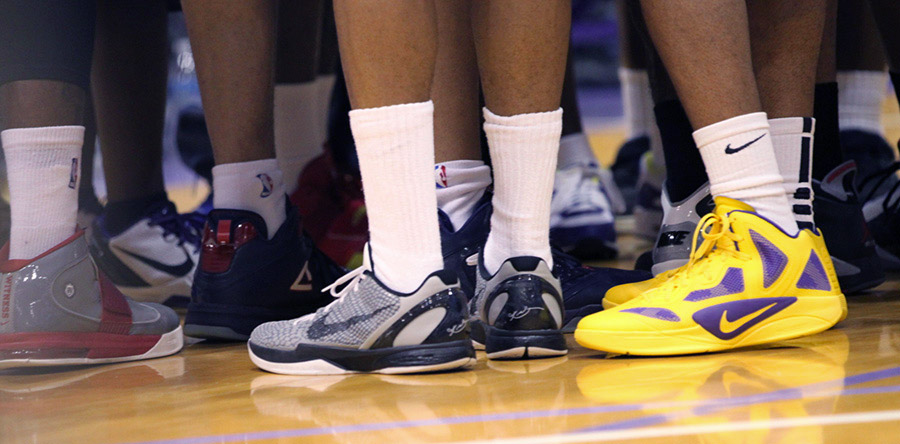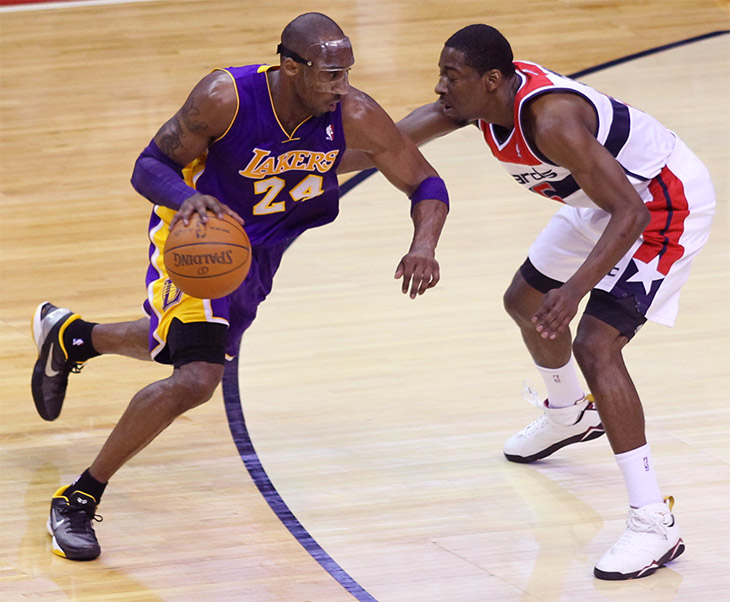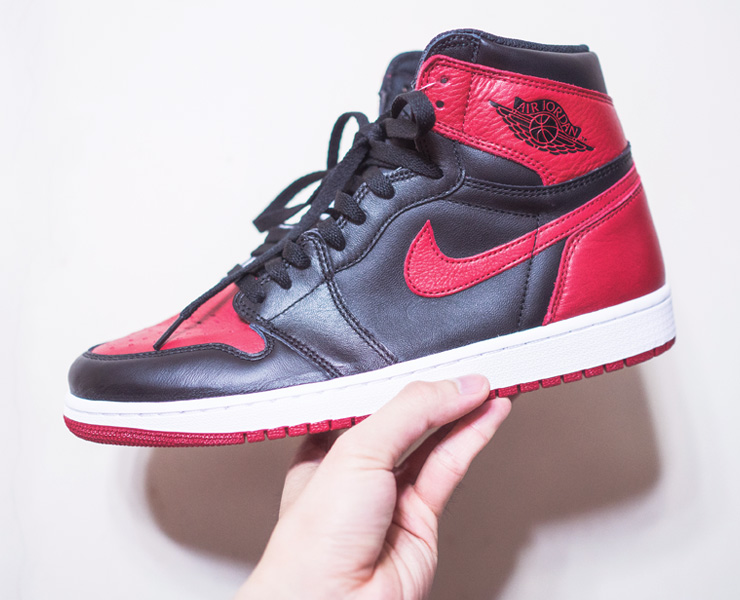The Science of Sneakers: High-Tops vs. Low-Tops
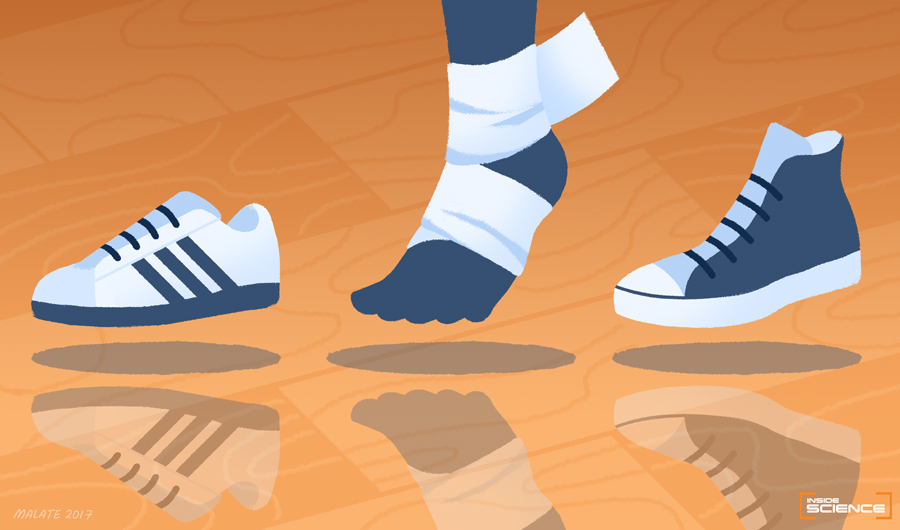
Image credits: Abigail Malate, Staff Illustrator
Rights information: Copyright American Institute of Physics (reprinting information)
(Inside Science) -- March Madness is upon us, full of buzzer-beaters and bracket-busters, Cinderellas and powerhouses. In the men's and women's NCAA tournaments, anything can happen. The difference between victory and defeat can come down to a wayward bounce of the ball -- or a turn of the ankle.
An ankle sprain is the most common way to get hurt in basketball, accounting for a quarter of all injuries by some estimates. Just ask the NBA's Stephen Curry, who last week twisted his ankle for the fourth time this season. The Warriors' title hopes may rest on his precarious ankles, which he tapes and braces for every game because of his well-documented injury history. Further protection, in principle, comes from his eponymous high-top shoes, made by Under Armour.
"In any sport, I think shoes are very, very important," said Joseph Hamill, a biomechanist at the University of Massachusetts Amherst. "The shoes themselves are designed to try and alleviate specific factors in terms of minimizing injury risk."
From the classic Chuck Taylors to the latest Air Jordans, basketball footwear has usually meant high-tops, whose higher cut ostensibly provides support against sprains. Over the years, basketball shoes have morphed from simple canvas footwear to an array of high-tech gadgetry and bold styles. As sneaker culture has flourished -- manifesting as a complex intersection of fashion, capitalism, politics, culture, race and society -- basketball shoes continue to be at the forefront of footwear technology. Whether it's cushioning air cells in the sole, new types of rubber for better traction, lighter materials, or even the more gimmicky inflatable ankle support of the Reebok Pumps, the basketball shoe has always been a marriage of form and function.
More about basketball from Inside Science:
Resting Healthy NBA Players During the Season May Not Help Them in Playoffs
March Madness Seeding May Undervalue Hot Teams
NCAA Tournament Math: More than Adding Up Ones, Twos and Threes
"It's gotta be the shoes," said Spike Lee, playing his character Mars Blackmon in Nike's legendary Air Jordan ad campaign that began in the late 1980s. Yes, shoes are important. But, when it comes to injury, they're not everything.
Highs and lows
In the beginning, high-tops ruled the basketball court. Not long after the invention of basketball in 1891, Spalding developed the first basketball shoe -- a high-top. Made of canvas, it had a thinner rubber sole compared to the Converse All-Stars, which debuted in 1917 and in 1934 became known as Chuck Taylors.
Although the safety feature of a high-top shoe would become a selling point, it probably wasn't an emphasis for early shoe designers. "The real reason why we had ankle-covering sneakers in the first place was that it was a reflection of the ankle boots that men were wearing," said Elizabeth Semmelhack, the senior curator for the Bata Shoe Museum in Toronto. Ankle boots were the norm in the late 19th century, and basketball shoes just reflected that style.
Adidas released the first low-top all-leather basketball shoe, the Superstar, in 1969. But over the 20th century, high-tops remained the standard. Then, in 2008, Nike released low-tops as part of its Nike Zoom Kobe line, and with the boost from the Los Angeles Lakers superstar's endorsement, low-tops have since surged in popularity. Players cite greater freedom in movement with a lower cut.
Today, about half of NBA players wear low-tops, according to Howard Osterman, the team podiatrist of both Washington's professional basketball teams, the NBA's Wizards and the WNBA's Mystics. The majority of college players also choose low-tops, said Patrick Talley, an athletic trainer for UCLA's women's basketball team.
Conventional wisdom would say the prevalence of low-tops is a recipe for more injuries. But most ankle sprains -- like the one Curry most recently suffered -- happen when one player lands on another's foot. The resulting forces are so high that no high-top could stop a sprain.
"There's no evidence that different types of basketball shoes prevent ankle injuries," said Jay Hertel, a professor of athletic training at the University of Virginia.
In general, study results are mixed. In particular, two of the more recent studies found no difference between high- and low-tops in how much an ankle turns and in the up-and-down motion of jumping and landing. According to the first study, high-tops might even delay the muscle's reaction to an ankle turn, raising the likelihood of a sprain. Another suggested that wearing high-tops increased the forces, and injury risk, on the Achilles tendon.
But those studies were biomechanical experiments, in which researchers measured the forces and movements in the feet of volunteers who ran, jumped, and cut in a lab. Because large-scale epidemiological studies of athletes playing basketball are difficult and expensive, they're rare. And none have conclusively implicated high- or low-tops in ankle injuries.
For example, a 1993 study surveying 622 college players found no difference in rates of ankle injury between high- and low-tops. In a larger study from 2001, researchers looked at more than 10,000 Australian basketball players, and didn't find high- or low-tops to be major risk factors for ankle injuries. Instead, increased risk was linked to prior injuries, whether a player stretched before the game, and the presence of air cells in the shoe -- like those in that era's Air Jordans. But even the importance of cushioning is muddled. A 2008 study, which surveyed 230 collegiate players, focused on springlike cushioning, and found that rates of ankle sprains didn't depend on shoe design.
Function, form -- and science
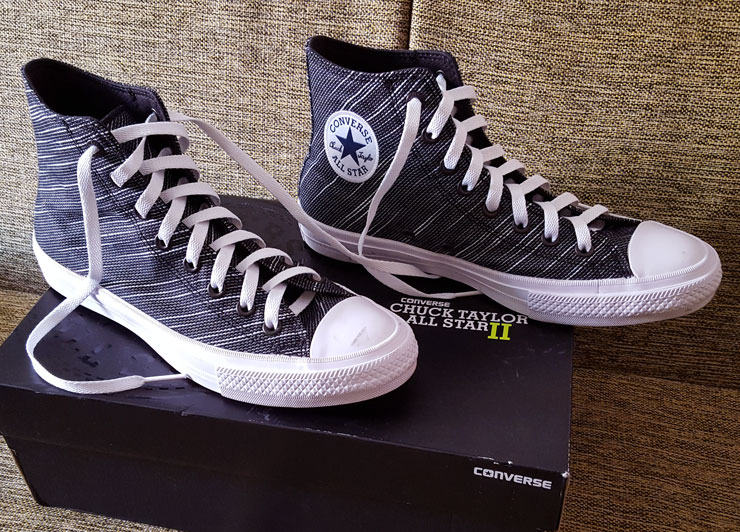
Converse Chuck Taylor All Star II Sneakers
Credit: Rachmanifnoff via Wikimedia Commons
License: CC BY-SA 4.0
Still, the cut and cushioning of a basketball shoe are only part of the design, which has come a long way since the Chuck Taylors. "Sneakers have always been interlaced with technological advances," Semmelhack said. Even the first basketball shoes were cutting edge, with soles made of rubber, a new and expensive material at the time. And the ankle patches on the early Chuck Taylors were also meant to cushion impacts, she said.
It may be difficult to distinguish real innovation from marketing, but for the most part, shoe companies do pour considerable research into their shoes. Before joining Adidas, Tobias Luckfiel thought shoe companies were full of fluff. "But I think we have a lot of people who want the best for the athlete," said Luckfiel, now a senior manager of sports science at Adidas based in Portland, where he helps develop new materials and tests footwear, measuring the traction, cushioning and stiffness.
Published studies on basketball shoes are scant -- especially compared to what’s been done on shoes in other sports such as running and soccer. But shoe companies do plenty of their own, unpublished work. "For everything we publish, we do 100 technical reports," said Matthew Nurse, the vice president of Nike's sport research lab in Portland. Nike researchers, he said, use motion-capture systems, sensors, cameras, and other tools to zoom in on how basketball players move. They have even used X-rays to gauge the effect shoes have on how much ankles turn inward while cutting. A 2017 report from Morgan Stanley estimates that Nike invested about $2.5 billion into overall research and development over the previous five years.
This research helps designers understand factors like traction, the stiffness of the sole, the height of the heel, and stability in the foot's side-to-side motion. Basketball shoes must be light and comfortable and offer cushioned support. They must allow for the foot's natural movements during play -- but not too much.
The problem is that basketball demands a diverse range of motion: jumping, landing, running, sliding side-to-side, and everything in between. "It's really difficult to design all of those characteristics into one basketball shoe," said Hamill, who, like many athletic shoe researchers, receives funding from shoe companies (he works with Brooks on running shoes and FootJoy on golf shoes).
And all those factors have trade-offs. A stiffer high-top, for example, may improve ankle support. But like with a ski boot, excess support transfers the forces -- and potential injuries -- upward to the knee. "You change one thing, and it's better for one area and unfortunately may be worse for the other," said Jeffrey Taylor, a physical therapist and biomechanist at High Point University in North Carolina, who receives research funding from Adidas.
Minimizing injury risk
The multitude of factors means the right basketball shoe must be specific to the individual. At the collegiate level, trainers like UCLA's Talley make sure each player wears the right shoe. In the NBA, about half of players use custom insoles, made from a computer scan of their feet, said Osterman, the Wizards’ and Mystics’ team podiatrist. The other half uses off-the-shelf insoles or those that come with the shoe. "The technology has gotten better, but the shoe by itself is probably not the end-all, and needs to be done in conjunction with an insole -- especially with a history of injury," he said.
At the highest levels of basketball, all players undergo rigorous strength and balance training to prevent injuries. And most do have their ankles wrapped. The coaches at UCLA require it during games and practice. And as many as 80 percent of NBA players use tape during games, Osterman said. Some studies suggest taping is beneficial, but not necessarily for the reasons you might think.
After a few minutes of action, tape tends to loosen, and no longer offers structural support. According to experts, the benefit of taping -- and braces -- is mainly proprioceptive, in which the tape’s contact with the skin induces the muscles to respond better and prevent injury. "If your ankle gets in a vulnerable position, your body will be able to sense that and contract muscles to help prevent the ankle from inverting too far," Hertel explained.
Taping and braces can also benefit the recreational player who has recently twisted an ankle. But in general, strength and balance exercises might be even more important. Hertel, for instance, suggests brushing your teeth on one leg.
When it comes to shoes, experts recommend wearing whatever feels the most comfortable and supportive. One of the main brands would likely be of better quality, Hamill said. But you don't need to break the bank, according to David Oji, an orthopedic surgeon at Stanford Health Care, where he also works with Stanford's varsity athletes. A cheaper shoe can be just as effective as an expensive option, he said.
More than footwear
But the purpose of basketball shoes has never been just to reduce injuries. For the top professional players, endorsement deals may be the biggest reason why they wear the shoes they do. Shoe companies also have big-money agreements with college teams, and have become embroiled in a scandal involving Adidas and multiple universities.
For most people, shoes are about comfort and style. Footwear is a fashion statement, and for men, Semmelhack argues, they have allowed expression in a way that preserves traditional masculinity.
Shoes are also political. Dwyane Wade has worn a special Black Lives Matter edition of his signature shoes. More recently, Curry donned custom shoes in support of former President Barack Obama's My Brother's Keeper alliance.
Sure, shoes protect your feet. But from social status to social justice, shoes have always meant something more -- regardless of who's wearing them.

